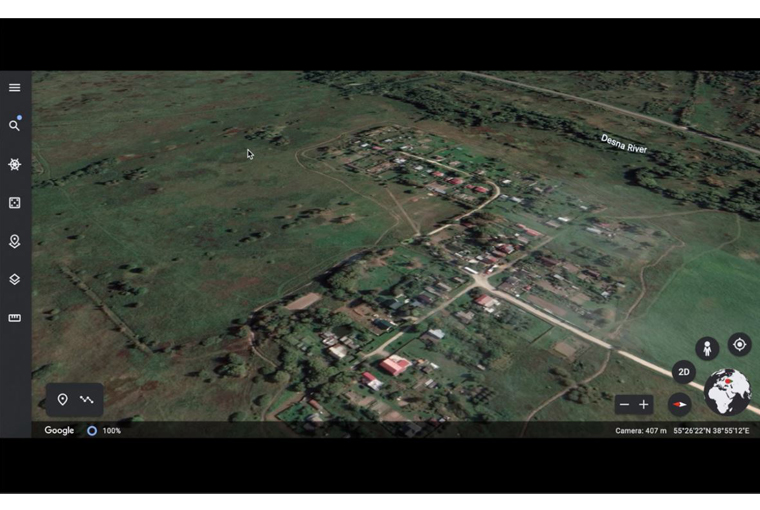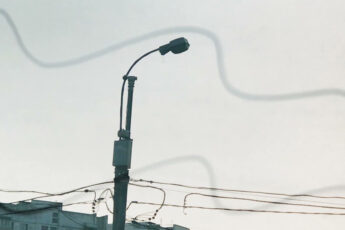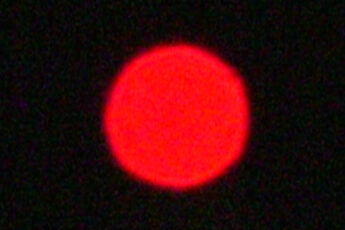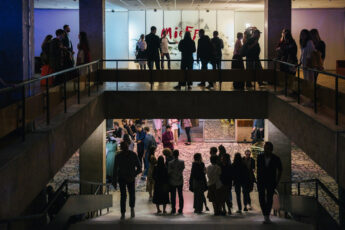From Russian Fields to Data Systems
Alexandra Anikina’s Data Field (2021)
Vol. 118 (October 2021) by Anna Doyle
With her 26-minute film Data Field, Alexandra Anikina examines digitality by putting us in touch with our analogue past. Data Field explores in-between temporalities and re-interprets the family diary film from the point-of-view of a time-gap, specifically that between our mythical past and technological ideas of progress. As technology and elaborate data systems continue to develop, it is useful to look back at the history of media in Russia before its contemporary and Western theorization. The film sets off in Alexandra Anikina’s grand-parent’s house and garden within the confines of a traditional Russian home, which is decorated with pictures and a sound system, and which is enclosed by a small garden and a title-lending field. The image of the field appears both analogically and digitally – sometimes resembling computerized images of Google Earth -, a contrast which is also reflected in the score, a mix between magical folk music and computerized tracks. The film does not tell a story, nor does it recite a poem. One could rather say that it is the visual documentation of a thought process.
In Anikina’s film, materialist visions are confronted with the mythical. Grandpa explains why he is an atheist: “Why am I an atheist? Well, I know that when there is a bright flash all of a sudden, and they say it’s Anokha flying and shooting, it’s not Anokha shooting. When you hear thunder: it is an interaction between two electric charges.” (“Anokha” being the name of a character from Slavic folklore.) Philosopher Francois Jacob has tried to explain the relationship between science and myth by stressing their similarities. Both are concerned with the question of cause and origins, and both trigger their explanation through the imagination of invisible forces: “For some, thunder translates the fury of Zeus, for others a difference of potential between earth and clouds”.1
The title-lending “data field” of the film is situated near Anikina’s grandparents’ home.2 At one point, the field is filmed from above in Google Earth. Data systems are not simply computer-based, nor do they reside within human consciousness, as is shown by many of the entities showcased during the film. Data systems reside within museums, in family genealogies, in Valdimir Propp’s morphology of fairytales and, crucially for the film, even in a rural field, if we allow for a broad definition of data systems as systems of organizing symbols and information. The field in the film is a place of identification for Anikina’s family and the local population. At the same time, by flattening the image of it and of the sky above it, Anikina makes the place lose its transcendental character. This materialist relation to the earth and to the sky is linked to technological exploration but also to Russian thought, where it is dominant in the cosmism of the first half of the 20th century, as mentioned in the film. Nicolas Fiodorov (1829-1903), the father of “Russian cosmism”, invented a movement of philosophy that sought humanity’s integration into the cosmos, rather than integrating the cosmos into humanity. For Fiodorov, it was a question of considering humans responsible for their life on our planet, which he understood as a common home that exists in permanent interchange with the cosmos. According to Fiodorov, human beings can become immortal by exploring space through science and technology, and by holding on to their faith in evolution. It is a form of esoteric futurism. However, Anikina seems more interested in cosmism’s links to the cult of ancestors and to Russian folklore than to its utopian ideals. Indeed, one of the aims of the film is to adopt a “utopian gaze” in order to deconstruct a monolithic vision of Soviet history which underplays its true complexity.
Denouncing monolithic visions of Soviet history is also a way of exploring complex temporalities. In the film, Russian history is not so much explored in the past as in our contemporary digital world. Cosmism for example was an inspiration for posthumanism. The filmmaker therefore sets the film in a vector of time where history is reconsidered and even put into question as a discipline. Quoting Franz Fanon’s Black Skin, White Masks, she states: “I immerse myself in history, realizing that history does not exist”. According to the film, monuments and monoliths (like Lenin’s mausoleum for example) are erected not so much for us to remember, but to transmit and influence our vision of the future. The film finishes with the words: “the body of history does not determine a single one of my actions. I am my own foundation. And it is by going beyond the historical instrumental hypothesis. That I will initiate the cycle of my freedom.” And finally, the observation is made that “late capitalism is not inclined to offer alternatives to itself.” In Anikina’s understanding, museums are not so much vestiges as non-human systems of symbols that put into question our way of understanding an unhealed Soviet past, whereas mythology exists in parallel with historical time.
Anikina finds the answer to this time-vector problem not only in the methods of experimental cinema (cf. her exploration of time vectors that is inspired by the work of Michael Snow) – but also in science fiction, specifically in the Strugatsky Brothers’ Monday Begins on Saturday from 1965. The story of the book takes place in a scientific research institute of magic and wizardry. The main characters of the story are trying to explain the secret of the institute’s director, who exists as two people. By way of explaining the phenomenon, the institute director puts forward his theory of countermotion – of travelling or moving back in time. Strugatsky’s novel relates this story to an event of a meteorite strike in Tunguska in 1908, transforming it into the story of an alien ship entering circumsolar space. Anikina says in the film that the aliens who arrived on earth in 1908 “were not the simple, artless aliens of science fiction novels. They were Countermovers. People who had arrived in our world from another universe where time flows in the opposite direction from ours, opposite time flows.” In the film, utopian imaginaries, science fiction and apocalyptic discourses are all seen as opposite flows of information that are counter-moving. Anikina reinterprets all these counter-moving flows of information to question discrepancies in time and history.
In Anikina’s film, media outlets in general and film in particular become ritually organized. Anikina speaks of “the process of making images anthropologically, as a particular kind of filmic-algorithmic techno-animism, a ritual that is enacted in the processes of visualizing”3. This ritual of film allows us to reinterpret digitality as a form of animism and reconsider the unidirectionality of time and movement. By breaking the time-space continuum and placing her film between the past and the future, between our earth and the extraterrestrial, we become as disoriented as is anyway dictated by the logic of late capitalistic postmodernity.
Bibliography
- 1.Jacob, François. La souris, l’homme, la mouche, 1997. Le beau et le vrai, Odile Jacob, Paris, 2000, pp. 186-189.
- 2.Anikina has elaborated on her own understanding of the term as follows in a conversation with myself: “Some people asked me what a `data field’ is, but the way I think about it is exactly what it sounds like. To start with, `data field’ is a somewhat bureaucratic name for a cell in an Excel spreadsheet – and this is an image that features in the second film, one that I’m making now. But `data field’ is also reminiscent of `noosphere’, a concept developed by Pierre Teilhard de Chardin, Édouard Le Roy and Vladimir Vernadsky. `Noosphere’ implies that the human cognition produces something comparable to a biosphere, something that alters it radically and something that is more than just a sum of all knowledge available. `Data field’, on the other hand, doesn’t put the human in the center, but rather implies the overwhelming primacy of informational infrastructures in which we exist. We all live in multiple `data fields’ of different kinds. And finally, it is also a very straightforward pun on the `field’ as a persistent visual metaphor for a place where a Russian soul can feel at home – if you look up any works by the 19-century painter Ivan Shishkin, you will immediately understand my reference point.’’.
- 3.Cf. interview author’s interview with Alexandra Anikina, forthcoming in this journal.




Leave a Comment